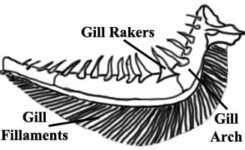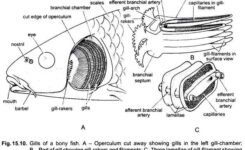RESPIRATORY SYSTEM
Respiratory system includes all the organs and tissues associated with the exchange of gases between the animal and its environment, leading to the release of energy. The purpose of respiration is to supply oxygen to the cell which burns down food to release energy.
C6H12O6 + 6O2 à 6CO2 + 6H2O + ENERGY
(Glucose) (Oxygen) (Carbon dioxide) (Water) (ATP)
TYPES OF RESPIRATION
- Aerobic respiration: This is the type of respiration that takes place in the presence of
oxygen.
C6 H12 O6 + 6O2 à 6CO2 + 6H2O + ENERGY
(Glucose) (Oxygen) (Carbon dioxide) (Water) (ATP)
- Anaerobic respiration – This is the type of respiration that takes place in the absence of oxygen. Anaerobic respiration is also known as fermentation.
C6H12O6 à 2C2H5OH + 2CO2 + ENERGY
(Glucose) (Alcohol) (Carbon dioxide) (ATP)
RESPIRATORY ORGANS
This refers to organ such as the lungs in land animals and gills in aquatic animals. Land animals use lungs for respiration. Other organs that aid respiration in land animals are the nostrils (two external openings of the nasal cavity in vertebrates that admit air to the lungs), pharnyx,Larynx (situated just below where the tract of the pharynx splits into the trachea and the oesophagus).
The trachea (windpipe) is a cartilaginous tube that connects the pharynx and larynx to the lungs, allowing the passage of air, and so is present in almost all air-breathing animals with lungs. The trachea extends from the larynx and branches into the two primary bronchi. Epiglottis disallows entrance of food particles into the trachea. bronchi is a passage of airway in the respiratory system that conducts air into the lungs.The bronchioles or bronchioli are the passageways by which air passes through the nose or mouth to the alveoli (air sacs) of the lung. Alveoli are tiny sacs within the lungs that allow oxygen and carbon dioxide to move between the lungs and bloodstream.
PROCESS OF BREATHING
Breathing process is an activity that takes place consciously or not, process of breathing moves air in and out of the lungs. Inward movement of air is called inhalation while exhalation is the outward movement of air from the animal body. Aquatic animals use gillswhich are located on both side of the head region for respiration. Thegills are in threes or fours arranged in the gill chamber. Each gill consist of a gill filament where gaseous exchange takes place, gill raker that prevent particlesfrom entering the gill chamber, gill arch on which the gill filament are built. The gill chamber is closed externally by operculum.


Diagram of fish gill
EVALUATION
- Describe the process of inhalation and exhalation.
- Differentiate between the two types of respiration.
IMPORTANCE OF THE RESPIRATORY SYSTEM
- Supplies oxygen to the body cells
- It reduces heat load in the body especially in poultry.
- Removes carbon dioxide from the body
- Promotes gaseous exchange
EVALUATION
- Define Respiration.
- List and explain the two types of respiration.
- How does fish respire in water?
- Represent Aerobic Respiration in chemical equation
- Describe the process of respiration in a named animal?
NERVOUS SYSTEM
The nervous system includes all the organs and tissues which enable farm animals to respond to changes in their environment. The change in the environment is called stimulus and the reaction of the living things to the stimulus is response. The nervous system is made up of two parts;
Central Nervous System: This includes the brain and the spinal cord. Both are made up of thousands of nerves and neurons. The functions of C.N.S. are correlation of impulses from various sense organs and storage of impulses as information. Peripheral Nervous System: This consists of cranial and spinal nerves. The P.N.S. mediates between animals and its external environment.
GENERAL EVALUATION
- Write brief notes on a) Respiratory system b) Nervous system
- Distinguish between the central nervous system and peripheral nervous system.
WEEKEND ASSIGNMENT
- The lungs is to rabbit while____ is to fishes A. trachea B. Gill C.bronchiD.oesophagus
- The wind pipe in the respiratory system of land animals is the A. Larynx B. Pharynx
- alveoli D. trachea
- Which of the following performs the same function in the gills as epiglottis A. Chamber B. Filament C. Operculum D.Raker
- The changes in environment that triggers response in animals is called A. Action
- Response C. Stimuli D. impulse
- The structural and functional unit of the nervous system is the ____ A. spinal cord
- brain C. neurons D. spinal fluid
THEORY
Describe briefly a simple reflex action in animals and state four examples
See also